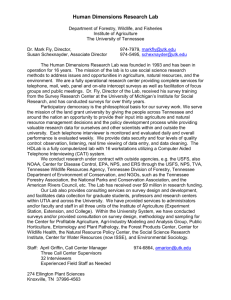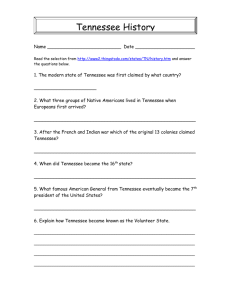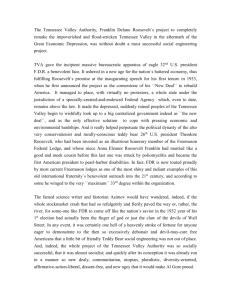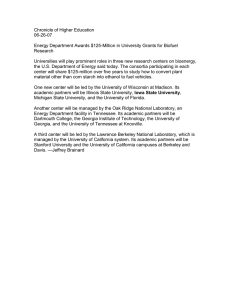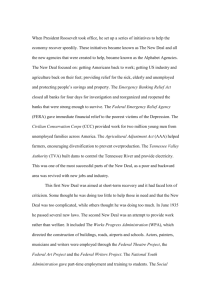Development and Management of Riparian Wildlife ... by the Tennessee Valley Authority
advertisement
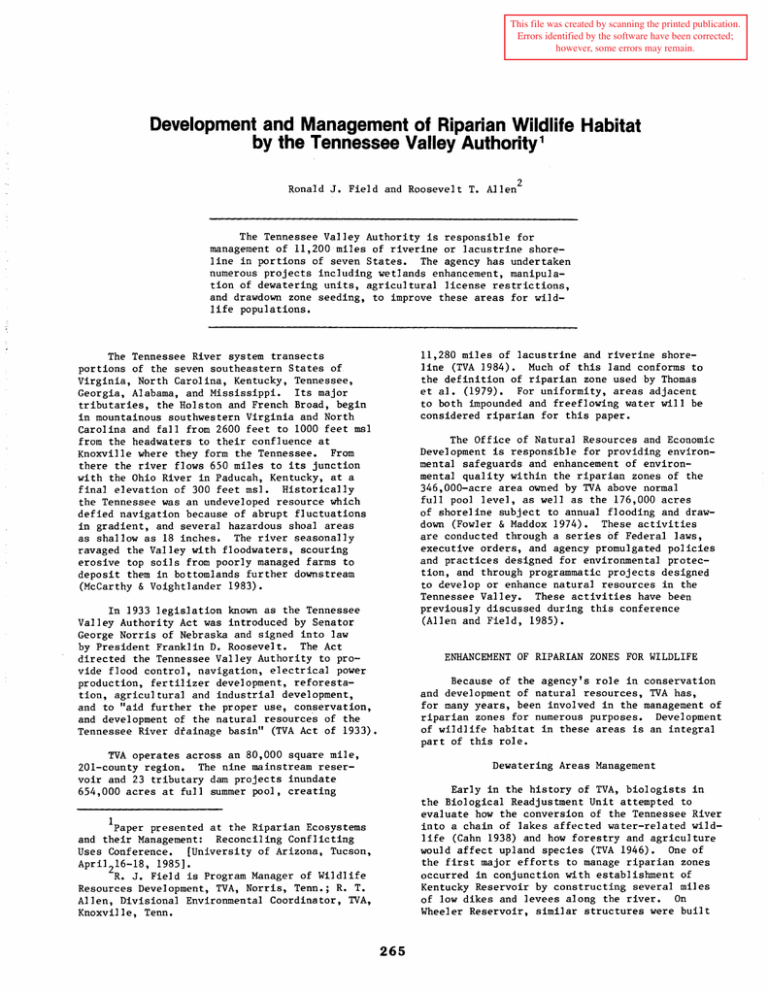
This file was created by scanning the printed publication. Errors identified by the software have been corrected; however, some errors may remain. Development and Management of Riparian Wildlife Habitat by the Tennessee Valley Authority 1 Ronald J. Field and Roosevelt T. Allen 2 The Tennessee Valley Authority is responsible for management of 11,200 miles of riverine or lacustrine shoreline in portions of seven States. The agency has undertaken numerous projects including wetlands enhancement, manipulation of dewatering units, agricultural license restrictions, and drawdown zone seeding, to improve these areas for wildlife populations. 11,280 miles of lacustrine and riverine shoreline (TVA 1984). Much of this land conforms to the definition of riparian zone used by Thomas et al. (1979). For uniformity, areas adjacent to both impounded and freeflowing water will be considered riparian for this paper. The Tennessee River system transects portions of the seven southeastern States of Virginia, North Carolina, Kentucky, Tennessee, Georgia, Alabama, and Mississippi. Its major tributaries, the Holston and French Broad, begin in mountainous southwestern Virginia and North Carolina and fall from 2600 feet to 1000 feet msl from the headwaters to their confluence at Knoxville where they form the Tennessee. From there the river flows 650 miles to its junction with the Ohio River in Paducah, Kentucky, at a final elevation of 300 feet msl. Historically the Tennessee was an undeveloped resource which defied navigation because of abrupt fluctuations in gradient, and several hazardous shoal areas as shallow as 18 inches. The river seasonally ravaged the Valley with floodwaters, scouring erosive top soils from poorly managed farms to deposit them in bottomlands further downstream (McCarthy & Voightlander 1983). The Office of Natural Resources and Economic Development is responsible for providing environmental safeguards and enhancement of environmental quality within the riparian zones of the 346,000-acre area owned by TVA above normal full pool level, as well as the 176,000 acres of shoreline subject to annual flooding and drawdown (Fowler & Maddox 1974). These activities are conducted through a series of Federal laws, executive orders, and agency promulgated policies and practices designed for environmental protection, and through programmatic projects designed to develop or enhance natural resources in the Tennessee Valley. These activities have been previously discussed during this conference (Allen and Field, 1985). In 1933 legislation known as the Tennessee Valley Authority Act was introduced by Senator George Norris of Nebraska and signed into law by President Franklin D. Roosevelt. The Act directed the Tennessee Valley Authority to provide flood control, navigation, electrical power production, fertilizer development, reforestation, agricultural and industrial development, and to "aid further the proper use, conservation, and development of the natural resources of the Tennessee River drainage basin" (TVA Act of 1933). ENHANCEMENT OF RIPARIAN ZONES FOR WILDLIFE Because of the agency's role in conservation and development of natural resources, TVA has, for many years, been involved in the management of riparian zones for numerous purposes. Development of wildlife habitat in these areas is an integral part of this role. TVA operates across an 80,000 square mile, 201-county region. The nine mainstream reservoir and 23 tributary dam projects inundate 654,000 acres at full summer pool, creating Dewatering Areas Management Early in the history of TVA, biologists in the Biological Readjustment Unit attempted to evaluate how the conversion of the Tennessee River into a chain of lakes affected water-related wildlife (Cahn 1938) and how forestry and agriculture would affect upland species (TVA 1946). One of the first major efforts to manage riparian zones occurred in conjunction with establishment of Kentucky Reservoir by constructing several miles of low dikes and levees along the river. On Wheeler Reservoir, similar structures were built 1 Paper presented at the Riparian Ecosystems and their Management: Reconciling Conflicting Uses Conference. [University of Arizona, Tucson, April 16-18, 1985]. 2 R. J. Field is Program Manager of Wildlife Resources Development, TVA, Norris, Tenn.; R. T. Allen, Divisional Environmental Coordinator, TVA, Knoxville, Tenn. 265 after impoundment (Weihe & Hess 1944). They were equipped with water control gates and massive pumps with up to 52,000 gallon per minute water movement capacity. The pumps were designed to remove the shallow, impounded water from areas behind these dikes during the spring and summer seasons. Through this dewatering process breeding habitat for the malaria vectoring Anopheles quadrimaculatus mosquito was eliminated. Eight of the dewatering units began operation during 1945, and two in 1949. The seasonal dewatering of slightly more than 13,000 acres of fertile bottomlands not only eliminated mosquito breeding areas, it enabled extensive production of agricultural crops and native moist soil plants such as smartweeds and millets (Weihe et al., 1950). Several thousand acres of lands in the units were licensed or transferred to the States or what is now the U.S. Fish and Wildlife Service, for the management of waterfowl and other wildlife. These units subsequently became a principal factor, in combination with the deteriorating wetlands habitat along the Gulf Coast, in establishing the Tennessee River Valley as a major wintering area for more than 1/2 million waterfowl annually, on an area that had formally held fewer than 10,000 birds. By 1962, 68 percent of the wintering waterfowl in the States of Tennessee and Alabama were located within the Tennessee Valley (TVA 1962). with backhoes, and some heavy equipment using draglines were used to remove obstructing materials from clogged ditches and repair eroded dikes. Helicopters were used to reseed spoil banks. Some timber salvage has been conducted to utilize standing timber before further deterioration occurs. Experiments are presently underway for reestablishing important bottomland hardwood stands in many arPas where water damage has resulted in the loss or removal of these species. Drawdown Zone Management The dewatering units located on Kentucky and Wheeler Reservoirs are readily accessible to waterfowl migrating along the Mississippi Flyway. The majority of the Tennessee River and its major tributaries, the Holston, French Broad, Clinch, and Little Tennessee, however, lie between the Mississippi and the Atlantic flyways. Their geographic location in the mountainous terrain of Virginia and North Carolina, combined with their major functions in flood storage and power production, long ago were identified as major impediments to effective management of wildlife on these upper reservoirs (Weihe 1946). The drawdown zone for flood water storage on tributary reservoirs may exceed 100 feet in some cases, making natural growth and maintenance of either emergent or submergent aquatic plants nearly impossible during the fall migrating and wintering periods for waterfowl. Consequently little food is present and few waterfowl use the region, even though Bellrose (1976) estimates that up to 3/4 million waterfowl overfly these areas during annual migrations. A combination of factors, including design of a detailed forest inventory procedure on TVA lands (Field et al, 1985) and record high spring water levels in 1983 and 1984, resulted in close scrutiny of the more than 3,000 acres of bottomland hardwoods in the dewatering areas. Several stands of timber were found to exhibit uneven symptoms of water induced stress. Efforts were quickly initiated to evaluate the extent of the problem and attempt to identify the source. A combination of techniques, including the use of high altitude color infrared photography, elevation surveys, and onsite vegetation analysis and inventory described elsewhere (Fowler et al., 1985), was used. This investigation resulted in the diagnosis of a major problem within three of the ten dewatering units. Increasing populations of beavers within the units had combined with siltation in several drainage ditches or canals, to effectively prevent removal of water from the seasonally flooded timber duripg the spring. This inundation during the growing season had caused tree mortality in several areas, and as the dead trees fell across drainage ditches, the problem was exacerbated. The magnitude of the situation required an extensive program of debris and silt removal to restore water management capability, which resulted in approximately 62 miles of ditch and levee renovation, at a cost of approximately $1.4 million. Fortunately, the initiation of this project coincided with passage of the 1983 Federal Jobs Bill (Public Law 98-8), and a large number of previously unemployed workers were hired to execute the renovation with minimum environmental disturbance. Following guidelines published by the International Association of Fish and Wildlife Agencies (McConnell et al., 1983), hand clearing operations, small tractors 266 Several techniques have been successfully employed to address this situation for the benefit of waterfowl and upland species. Fowler and Whelan (1980) clearly showed the value of drawdown zone seeding for deer on TVA reservoirs. Earlier work by Fowler and Maddox (1974) and Fowler and Hammer (1976) identified effective techniques for applying seed and fertilizer to both mudflats and steep shorelines along reservoirs, using a barge mounted hydroseeder or aquaseeder, an air cushion vehicle, and a helicopter. Each exhibited some advantages under specific conditions. In 1982 TVA initiated a program on Douglas Reservoir to establish suitable habitat and food for migrating waterfowl. Initially the project involved the hand clearing of woody vegetation and use of a rice terrace plow to temporarily retain standing water after the summer reservoir drawdown. Areas adjacent to the temporary subimpoundment were seeded with a mixture of Japanese millet and buckwheat in order to provide adequate food for incoming birds. Portable pumps were used to pump water up from the reservoir to flood the sites. Initial efforts in the 740-acre area were moderately successful and encouraging. Although unusually dry weather and porous soil inhibited water retention, informal surveys suggested increased use of the area by both migrant waterfowl and deer. Efforts were consequently expanded and row crop licensing, be reviewed by a wildlife biologist. In tracts of sufficient size, configuration, or placement to be important, special requirements such as buffer strips of unmowed natural vegetation adjacent to the reservoir, maintenance of ditches or gullies in native vegetation, or leaving a percentage of grain crops for wildlife use, are incorporated within the license agreement. Agency lands licensed for livestock pasturage are also being reviewed to determine whether rest-rotation grazing schemes (Kauffman and Krueger 1984) may be practical on these areas. sand bags were used to build low dikes in runoff areas, thus creating 12 shallow ponds or sloughs ranging in size from 1/10 to 4 acres. These areas contained large quantities of natural moist site vegetation, which was supplemented with seeded cereal crops. Surveys during September 1984 indicated several thousand shore and wading birds, including great egrets, white ibises, and herons; 900-1000 wood ducks, and large numbers of teal, mallards, and Canada geese, made extensive use of the area. A major increase in white-tailed deer use of the project area also occurred, which was attributed to availability of natural and domestic food plants. A total of 22 deer were legally harvested from the 740-acre area in 1984, the first year of open hunting on the site. Other Projects Nolichucky Project A major project on one of the second order tributaries of the Tennessee is TVA's Nolichucky Waterfowl Sanctuary and Environmental Study Area in eastTennessee. The Nolichucky Dam, built in 1913 as a small hydroelectric project, initially impounded some 21,750 acre feet of water covering approximately 635 surface acres (TVA, 1972). Mica and feldspar mining operations in the North Carolina watershed, however, caused extensive siltation in the reservoir, gradually reducing storage capacity. By 1970 less than 25 percent of this storage remained, and by 1980, 90 percent had been eliminated. In 1972, TVA retired the facility and designated the 1,000-acre project as a waterfowl sanctuary and environmental study area. Water levels were manipulated using a 2~foot scheduled drawdown to seasonally expose 70 acres of mudflats. These areas were seeded to millet, buckwheat, sorghum, and other cereals, and reflooded during the fall and winter for migrating waterfowl. The mudflats also supported numerous native species including smartweeds and sedges. Concomitantly, upland areas adjacent to the reservoir were planted to hedgerows of autumn olive, sawtooth oak, and bicolor lespedeza, and nest boxes were built and placed for bluebirds, wood ducks, and other species. The result has bee~ an influx of breeding wood ducks, with 1983 nighttime float counts as high as 3.5 broods and 38 birds per mile of impounded water, and winter~ng waterfowl counts ranging between 2,000 and 3,000 birds. Numerous other less conspicuous but very important projects have been established on TVA's riparian lands for the benefit of wildlife. These include Valley-wide wood duck habitat evaluation and cooperative wetlands mapping with the U.S. Fish and Wildlife Service in the National Wetlands Inventory program. Another important action has been the establishment of two eagle sanctuaries covering approximately 1000 acres of land and water surface on TVA's Land Between The Lakes (LBL). These sanctuaries were established in 1974 and 1981 to secure an area frequented by relatively large numbers of wintering bald and golden eagles. An average of 50 eagles, at times ranging as high as 85, winter on the 170,000 LBL area and a communal roost has been documented within one of the sanctuary areas. Establishment of these sanctuaries has been an integral aspect of TVA's raptor restoration and management projects. These include a cooperative bald eagle restoration effort involving State, other Federal agencies, and private conservation organizations which have resulted in the release through hacking of 12 young and 2 rehabilitated adult bald eagles at LBL since 1980, and an additional 8 bald, 24 golden eagles, 131 ospreys, and 8 peregrine falcons at other sites. This project resulted during 1984 in the first successful nesting of a captive reared bald eagle in the wild (Hammer et al., 1984). CONCLUSION Agricultural Practices Nearly 20,000 acres of TVA's reservoir lands are licensed to local farmers for hay/pasture or row crop production. In many areas soils are highly erosive and most are subject to irregular inundation during periods of unusually high water. Poor farming practices, historically a problem in the Tennessee Valley, have sometimes been employed on these licensed lands, resulting in soil erosion and decreased water quality in adjacent reservoirs. Consequently in 1982, TVA implemented a program designed to curtail riparian zone erosion and simultaneously enhance lands under agricultural license for wildlife. A policy was established which required that each tract of land subject to 267 TVA has been active in the management of riparian lands under its ownership since its inception in 1933. Many of the techniques that have been used have involved innovative approaches to management of vegetation, and consequently wildlife, in conjunction with water level manipulations. Other efforts have concentrated on protection of riparian habitat. Additional techniques including comprehensive land use planning and compartmental forest management have been discussed elsewhere (Field et al., 1985) and blend well with the overall conservation and development responsibility of the Tennessee Valley Authority. These techniques, and others yet to be developed, contribute to the maintenance of environmental quality in the Tennessee River Valley. LITERATURE CITED Allen, R. T., and R. J. Field. 1985. Riparian Zone Protection by TVA: An Overview of Policies and Programs. Proc. of 1985 Riparian Ecosystem Management Conference (In Press). Bellrose, Frank C., 1976. Ducks, Geese and Swans of North America. A Wildlife Management Institute Book sponsored jointly with the Illinois Natural History Survey. Stackpole Books. Harrisburg, PA. 544 pp. Cahn, A. R., 1938. The work of the TVA in relation to the wildlife resources of the Tennessee Valley. Jl. of the Tenn, Acad. of Sci. 13(3):174-179. Field, R. J., D. C. Forbes, and L. M. Doyle, 1985. Multiple-use management on Tennessee Valley Authority lands. Trans. 50th North Am. Wildlife and Nat. Res. Conf. (In Press). Fowler, D. K. and J. B. Maddox, 1974. Habitat improvement along reservoir inundation zones by barge hydroseeding. Jl. Soil & Water Cons. 29(6):263-265. Fowler, D. K. and D. A. Hammer, 1976. Techniques for establishing vegetation on reservoir inundation zones. Jl. Soil & Water Cons. 31(3):116-118. Fowler, D. K. and J. B. Whelan, 1980. Importance of inundation zone vegetation to white-tailed deer. Jl. of Soil & Water Cons. 35(1):30-33. Fowler, D. K., W. K. James, and D. Becker, 1985. Use of infra-red photography to identify bottomland hardwood stands damaged by standing water. Presentation at 1985 Soil Cons. Soc. of Amer. annual meeting (In preparation). Hammer, D. A., J. L. Mechler, M. E. Cope, and R. L. Lowe, 1984. Successful wild nesting of a three-year old captive reared bald eagle (Abstract). Raptor Research Foundation annual meeting, Blacksburg, VA. Kauffman, J. B. and W. C. Kreuger, 1984. Livestock impacts on riparian ecosystems and streamside management implications • • • a review. Jl. Range Management 37(5):430-437. 268 McCarthy, D. M. and C. W. Voightlander, Editors, 1983. The first fifty years: changed land, changed lives. State-of-the-environment in the Tennessee Valley--1983. Tennessee Valley Authority, Knoxville, TN. 212 pp. McConnell, C., A. Burns, E. Claire, D. Huff, J. Karr, G. Montgomery, D. Parsons, J. Sedell, and M. Seehorn, 1983. Stream obstruction removal guidelines. International Assoc. of Fish & Wildlife Agencies, The Wildlife Society, and The Am. Fisheries Soc., Bethesda, MD. 10 pp. Tennessee Valley Authority Act (PL 48-58, 18 May 1933). Tennessee Valley Authority 1946. Biological Readjustment Division. Annual report, fiscal year 1946. Rept. 190-46. Norris, TN. Tennessee Valley Authority 1962. Annual report FY 1962. Division of Forestry Development. Norris, TN. Tennessee Valley Authority, 1972. Environmental Statement: Rehabilitation of Nolichucky Project. TVA-OHES-EIS-72-2. Chattanooga, TN. 17 pp & appendix. Tennessee Valley Authority. 1984. TVA Handbook. Knoxville, Tennessee. 261 pp. Thomas, J. W., C. Maser, and J. E. Rodiek. 1979. Wildlife Habitats in Managed Rangelands--The Great Basin of Southeastern Oregon. Riparian Zones. USDA Forest Service General Technical Report PNW-80. 18 pp. Weihe, A. H. 1946. Improving Conditions for Migratory Waterfowl on TVA Impoundments. Jl. Wildlife Mgt. 10(1):4-8. Weihe, A. H. and A. D. Hess, 1944. Mutual interests of wildlife conservation and malaria control on impounded waters. Jl. Wildlife Mgmt. 8(4):275-283. Weihe, A. H., E. R. Cady and P. Bryan, 1950. Waterfowl on the Tennessee River impoundments. Trans. 15th North Am. Wildlife Conf. 15:111-117.
